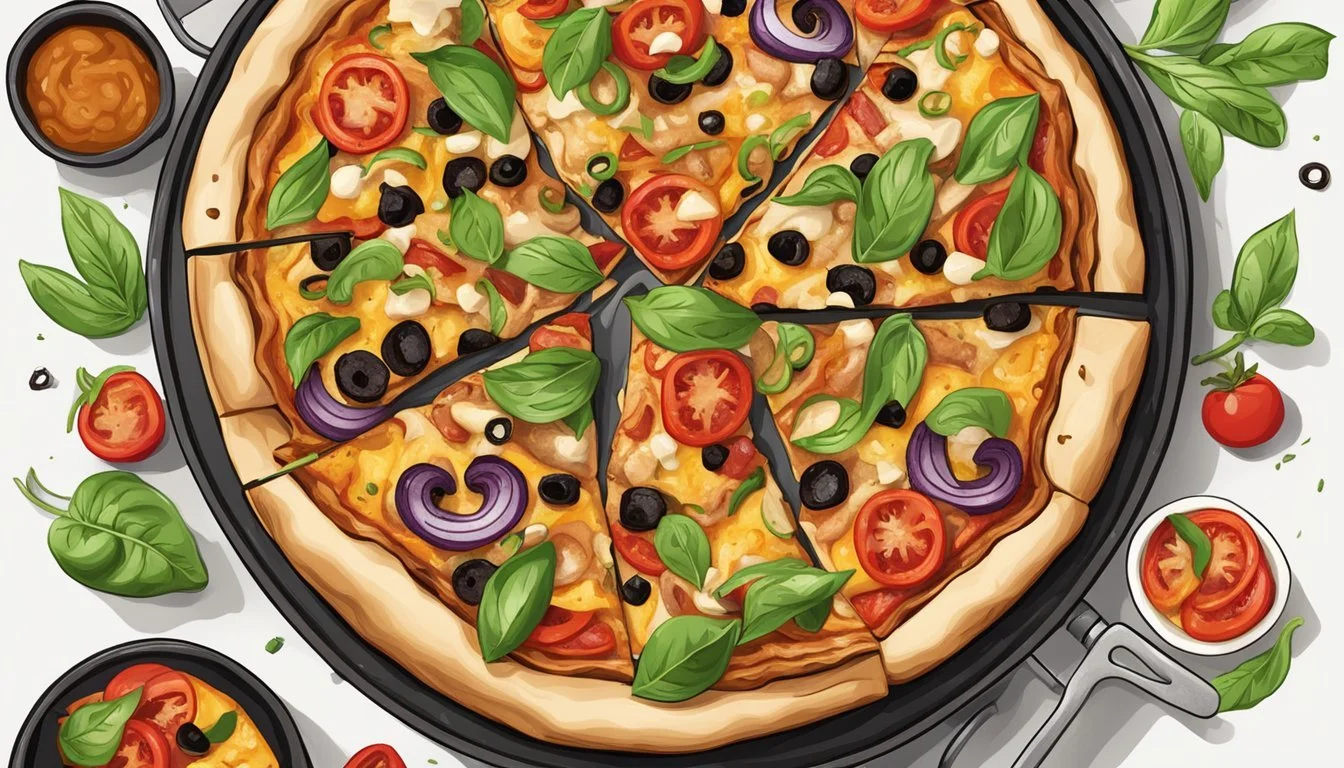Is Grilled Pizza Vegan?
Understanding Ingredients and Preparation
Grilled pizza (What wine goes well with pizza?) has become a popular twist on traditional oven-baked pizzas, offering a unique flavor profile due to the high heat and smoky essence from the grill. The question of whether grilled pizza can be vegan is an interesting one as it hinges upon the choice of ingredients used in the preparation of the pizza. Veganism excludes all animal products, which means that a pizza must have a crust, sauce, and toppings all devoid of meat, dairy, and other animal-derived substances to be considered vegan.
The versatility of pizza makes it a canvas for various dietary preferences, including veganism. A vegan grilled pizza would utilize a crust made from ingredients like flour, water, salt, and yeast, without the inclusion of eggs or dairy products that some pizza dough recipes might call for. The toppings can include an array of vegetables, vegan cheeses, and plant-based proteins that cater to those looking to enjoy the grilled pizza experience without compromising their vegan dietary restrictions. The grilling process itself does not affect the vegan status of the pizza, as it is merely a cooking method, leaving flavor and texture as the primary differences from oven-baking.
What Makes Pizza Vegan?
In the realm of pizza, vegan options cater to those seeking to avoid all animal products. The transformation of traditional pizza into a vegan-friendly dish involves substituting ingredients like cheese and meat with plant-based alternatives.
Defining Vegan Pizza
A vegan pizza is defined by its exclusion of animal-based ingredients. Pizzas traditionally include cheese, which is typically made from cow's milk, and often feature various meats or contain ingredients like honey or eggs. Vegan pizzas instead utilize vegan cheese, which is often made from nuts, soy, or other plant-derived substances designed to melt and stretch similar to traditional cheeses.
In addition to cheese, all other toppings and the crust must be plant-based. For a pizza to be considered vegan:
Crust: It must contain no dairy, eggs, or animal-derived enzymes. A basic vegan crust usually includes flour, yeast, water, salt, and sometimes sugar and oil.
Sauce: Tomato sauces are generally vegan, but one must ensure no cheese or animal products are included.
Toppings: Options include vegetables, fruits, beans, legumes, tofu, tempeh (What wine goes well with tempeh?), or seitan (What wine goes well with seitan?) rather than meats. Many plant-based meats are also available.
In short, vegan pizza accommodates both the dietary restrictions and the ethical choices of a vegan lifestyle by ensuring every component is plant-based.
Grilled Pizza Fundamentals
When crafting a grilled pizza, the nuances of grilling techniques are crucial for achieving the ideal texture and a crispy crust.
Grilling Techniques for Pizza
The process starts with heating the grill to a high temperature, which in the realm of grilling pizzas, is typically between 400°F to 500°F. This high heat is necessary to produce a crispy bottom crust that's a signature of grilled pizza. One should always ensure the grill grates are clean and then grease them to prevent the dough from sticking.
Vegan grilled pizza requires modifications, like using vegan dough and plant-based toppings. Operators of the grill should remember to use a separate utensil set if they also handle non-vegan food to avoid cross-contamination.
Here is a step-by-step approach:
Prep the Dough: It should be rolled or stretched into the desired shape.
Oil Up: Lightly oil one side of the dough. Place the oiled side down onto the hot grill.
Grill One Side: Close the lid and grill for about 1-2 minutes until it's marked and puffy.
Flip Carefully: Use a spatula or tongs to flip the dough, then quickly add toppings.
Finish Grilling: Close the lid again and grill for an additional 3-5 minutes until the cheese alternative melts and the crust reaches the desired crispiness.
Throughout the grilling process, attentiveness is key as the dough can go from perfectly charred to burnt in a matter of seconds due to the BBQ's direct heat. Grilled pizzas allow for a smoky flavor that's difficult to replicate with conventional ovens, making them a unique and favored variety of pizza especially suitable for outdoor events and summer meals.
Vegan Pizza Dough Preparation
Preparing vegan pizza dough requires careful selection of plant-based ingredients and precise mixing techniques to ensure the best quality and flavor. This will set the foundation for creating a delicious vegan grilled pizza.
Selecting the Right Ingredients
To start with a solid foundation for vegan pizza dough, one must select quality ingredients. The type of flour used greatly affects the texture; 00 flour or all-purpose flour are commonly used, with 00 flour creating a lighter, airier crust. Use warm water to activate the yeast—active dry yeast is a popular choice for its reliability. Ensure that the salt is fine grain to evenly distribute through the dough, and if a gluten-free option is desired, select a suitable gluten-free flour blend often containing xanthan gum as a binding agent. Baking powder may be used as a leavening agent in place of yeast for some gluten-free recipes.
Flour: 00 or All-Purpose Flour
Warm Water: Between 100-110°F (38-43°C)
Salt: Fine Sea Salt for Even Distribution
Yeast: Active Dry Yeast, Ensure Freshness
Optional: Baking Powder (for some gluten-free variants)
Mixing and Resting the Dough
Once the ingredients are gathered, combine them in a bowl and mix thoroughly. Start by activating the yeast in the warm water with a pinch of sugar if needed, waiting until it becomes foamy, indicating activity. Gradually incorporate the flour and salt, mixing to create a cohesive dough. If using gluten-free flour, additional binding agents like xanthan gum are often already included in the mix.
Kneading can be done with a stand mixer using a dough hook attachment or by hand on a floured surface. After kneading, the dough should rest until it doubles in size—placing it in a warm environment will speed up this process. Optionally, cornmeal can be sprinkled on surfaces for added texture and to prevent sticking. Below is a simple checklist for the process:
Activate yeast in warm water.
Mix in flour and salt.
Knead until smooth and elastic.
Allow to rest until doubled in size.
Use cornmeal for dusting surfaces as needed.
By following these specific steps, one can create a vegan pizza dough base that’s ready for grilling into a sumptuous vegan pizza.
Choosing Vegan Toppings and Sauces
When creating a vegan grilled pizza, the selection of toppings and sauces becomes crucial. Vegan cheese alternatives, a variety of fresh vegetables, plant-based proteins, and the choice between homemade and store-bought sauces all contribute to a flavorful, cruelty-free pizza experience.
Vegan Cheese Alternatives
Vegan cheese has come a long way, with options like cashew-based creams and other non-dairy alternatives taking center stage. Cashew ricotta is a popular choice for its creamy texture, and store-bought vegan mozzarella shreds melt well for a traditional pizza experience.
Fresh Vegetable Selection
Hearty vegetables such as mushrooms, zucchini, and artichokes offer a satisfying bite, while black olives and roasted red peppers bring a punch of flavor. Fresh basil, arugula, and cherry tomatoes add brightness and a hint of sweetness. When using onions, like red onion, it's important to sauté them first to bring out their natural sugars and soften their texture.
Plant-Based Proteins
Beyond vegetables, incorporating plant-based proteins can add both texture and nutritional value. Consider options like marinated tofu, tempeh, or legume-based meats as toppings. These proteins absorb flavors well, especially when seasoned with herbs, and can be grilled before adding to the pizza for an extra layer of smokiness.
Homemade vs. Store-Bought Sauces
The base sauce lays the foundation for the overall taste of the pizza. Tomato sauce, seasoned with olive oil, garlic powder, and dried herbs like oregano and thyme, is a classic choice. For something different, a vegan pesto or a cashew-based Alfredo sauce can be used. One might opt for homemade sauces to control the ingredients or choose store-bought for convenience, paying attention to ensure they are indeed vegan.
Assembling and Cooking the Pizza
In assembling and cooking vegan pizza on a grill, one must pay attention to ingredient choices and grill techniques to ensure that the crust attains the desired crispiness and the toppings are adequately cooked.
Layering the Ingredients
The cornerstone of a vegan grilled pizza is a suitable vegan pizza dough, which can either be homemade or store-bought. Prep time varies based on the recipe but typically includes 30-60 minutes for the dough to reach room temperature. Once the dough is ready and stretched on a surface lightly dusted with cornmeal or flour, one should begin layering the ingredients. A thin layer of olive oil brushed on the dough can prevent sogginess and enhance flavor. Following the oil, the chef should spread the sauce evenly, leaving space at the edges for the crust. It is crucial to top with vegan cheese and selected toppings, ensuring they are distributed evenly for consistent cooking and flavor.
Recipe: Vegan pizza with chosen toppings
Total Time: Varies based on grill temperature and topping density
Grilling for the Perfect Crust
Cooking the pizza crust on the grill involves preheating the grill to a medium-high heat, aiming for temperatures between 450-500 degrees Fahrenheit. One should grease the grill grates to prevent sticking. The pizza, ideally on a piece of parchment paper for easier handling, is then gently placed onto the grates. Closing the lid of the grill, one allows the pizza to cook for 3-5 minutes until the crust is crispy and the toppings have melted together harmoniously.
Cook Time: Approximately 3-5 minutes
Crust: Golden and crispy
The key is to monitor the pizza closely, as grill heat can vary. A perfectly grilled vegan pizza demonstrates a golden crust with a slight char and toppings that exhibit a melded and heated-through appearance.
Flavor Enhancements and Variations
When crafting a vegan grilled pizza, the flavor profile can be elevated through the use of a variety of seasonings and condiments, as well as by exploring different global pizza styles that lend themselves to plant-based adaptations.
Seasonings and Condiments
An array of herbs and spices can dramatically transform the taste of a vegan grilled pizza. Consider the following seasonings for a rich flavor:
Sea Salt and Black Pepper: Fundamental for enhancing overall taste.
Red Pepper Flakes: Adds a spicy kick to every bite.
Oregano: A classic pizza herb that offers a touch of earthiness.
Rosemary: Its piney aroma pairs well with savory toppings.
Nutritional Yeast: Offers a cheese-like flavor, often used as a dairy substitute.
Garlic Powder: A versatile seasoning that provides a pungent, sharp taste.
Condiments can also bring a depth of flavor to vegan pizzas:
Balsamic Glaze: A thick, sweet reduction that can be drizzled over the top.
BBQ Sauce: A tangy addition that pairs well with heartier toppings like barbecued cauliflower.
Bold flavors like these are essential in crafting a memorable vegan grilled pizza.
Exploring Different Pizza Styles
Different pizza styles can inspire vegan variations with their unique flavor profiles:
Neapolitan: Traditionally emphasizing tomato and fresh herbs, a vegan Neapolitan pizza might substitute cheese with a cashew-based spread.
Sicilian: Typically thick and square-shaped, offering a hearty crust that can be topped with a robust assortment of plant-based toppings.
By incorporating globally inspired pizzas into their repertoire, chefs can cater to diverse palates and dietary preferences while maintaining a vegan approach.
Serving and Enjoying Grilled Vegan Pizza
When serving grilled vegan pizza, presentation is key, and the right pairings can elevate the experience. This section provides guidance on showcasing your pizza and what to serve alongside it for a memorable meal, especially during summer gatherings.
Creating the Perfect Presentation
One should serve grilled vegan pizza hot, with a golden-brown crust and a vibrant display of toppings. Arranging the pizza on a wooden board adds a rustic touch that complements the grill marks. For multiple servings, consider cutting the pizza into uniform slices to make sharing easier. Display it alongside a sprinkle of fresh herbs, such as basil for an Italian flair, heightening not only the taste but also the visual appeal.
Accompaniments and Pairings
To complete the meal, consider pairing the pizza with a fresh salad; a mix of arugula, cherry tomatoes, and balsamic dressing is a refreshing choice. For beverages, a light-bodied white wine or a chilled craft beer can complement the pizza without overpowering its flavors. If one is counting calories, a sparkling water with a twist of lemon serves as a guilt-free option. Always consider the pizza's toppings when selecting pairings to create a balanced and enjoyable combo.
Special Dietary Considerations
When creating a vegan grilled pizza, one must not only consider the absence of animal products but also accommodate various dietary restrictions and preferences such as gluten-free or yeast-free diets.
Gluten-Free and Yeast-Free Options
For individuals requiring gluten-free options, one can utilize a variety of gluten-free flours such as rice, almond, or chickpea flour. These flours make an excellent base for the crust and cater to those with gluten sensitivities or celiac disease. It is important, however, to ensure that the flour blends are also free from additives that may contain gluten.
Yeast-free pizza dough can be made using baking powder or a combination of lemon juice and baking soda as leavening agents. These alternatives help the dough to rise without the need for yeast, which is beneficial for those with yeast allergies or intolerances.
For toppings, dairy-free cheese shreds are available that melt well and mimic the texture and taste one expects on pizza. Many brands offer soy-free and vegan cheese options, making them suitable for individuals avoiding soy products. Moreover, one can opt for fresh toppings like tomatoes, olives, or corn to enhance the flavor profile without compromising dietary needs.
To substitute traditional meats, one might consider lentils or other legumes to maintain a hearty texture and add additional protein to the pizza. Always verify that these substitutes do not contain any undesired additives that could conflict with dietary restrictions.
It's important to carefully read labels and inquire about cross-contamination if purchasing pre-made gluten-free or yeast-free doughs to ensure they meet the required dietary standards.
Conclusion: Embracing the Vegan Grilled Pizza Experience
Grilled pizza presents a delightful opportunity for vegans to enjoy a smoky, flavorful twist on a classic favorite. Vegan grilled pizzas combine diverse vegetable toppings and dairy-free cheese with the unmistakable charred crust that only a grill can impart.
Ingredients Selection:
Key to a successful vegan grilled pizza is the selection of high-quality ingredients. Vegan cheese should melt well, and a variety of fresh vegetables like zucchini, bell peppers, and onions add both flavor and nutrition.
Vegan Crust: Often yeast-free, ensuring quick preparation.
Vegetable Toppings: Should be grilled prior to being added to the pizza to ensure a soft texture and enhanced flavor.
Vegan Cheese: Needs to be chosen for its melting qualities.
Cooking Technique:
Temperature control is crucial. Grills should be preheated to around 400°F to 480°F, which helps in achieving a crispy crust without burning it. The dough should be rolled evenly to avoid uneven cooking.
Grill Marks: Sought after for aesthetics and flavor.
Direct Heat: Used for cooking the pizza quickly and thoroughly.
Environment and Health Benefits:
Choosing vegan options contributes to a lower environmental footprint and can offer health benefits. Grilled vegan pizza is a testament to the versatility of plant-based cuisine, demonstrating that sustainable choices do not compromise on taste.
In essence, vegan grilled pizza is not only possible but is a gastronomically rewarding experience that aligns with healthful living and environmental consciousness. Whether homemade or ordered from an establishment that caters to plant-based diets, it offers a satisfying meal that stands on its own culinary merits.








